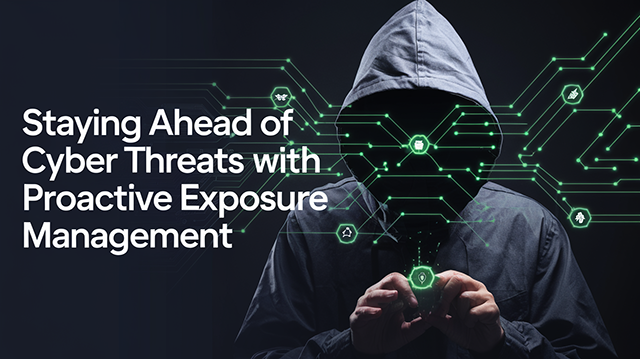Staying Ahead of Cyber Threats with Proactive Exposure Management

Overview
As organisations face an increasingly complex and evolving threat landscape, proactive cybersecurity measures have become critical. This article explores Proactive Exposure Management, a forward-looking strategy that leverages artificial intelligence (AI) and advanced technologies to identify, assess, and mitigate potential security risks before they can be exploited. By adopting this approach, businesses can enhance their security posture, reduce vulnerabilities, and stay ahead of emerging cyber threats.
Introduction
The cybersecurity landscape is constantly evolving, and with the rise of sophisticated attacks, organisations are shifting from reactive to proactive exposure management. Proactive Exposure Management is a comprehensive strategy designed to continuously monitor, assess, and mitigate risks across an organisation's entire digital ecosystem, ensuring that vulnerabilities are addressed before they can be exploited by malicious actors.
AI in Exposure Management
AI is transforming cybersecurity by enabling advanced threat detection, risk assessment, and automated mitigation. AI-driven tools offer real-time insights and predictive capabilities that far surpass traditional methods, helping organisations stay ahead of emerging threats.
Key AI Applications in Exposure Management
- Predictive Analytics: AI can analyse historical and real-time data to detect patterns and predict potential vulnerabilities. This allows security teams to act preemptively, addressing weaknesses before they can be exploited.
- Real-Time Threat Detection: AI-powered tools can monitor large volumes of data in real time, detecting threats and anomalies as they happen. This capability allows organisations to respond to incidents quickly and effectively.
- Automated Risk Assessment: AI streamlines risk assessments by evaluating various risk factors, automating the process to provide more timely and accurate insights.
- Enhanced Decision-Making: AI-generated data-driven insights support informed decision-making in risk management, enabling security teams to respond to threats more strategically.
Continuous Threat Exposure Management (CTEM)
CTEM represents a systematic approach to identifying and addressing vulnerabilities across an organisation's entire attack surface. Introduced by Gartner, this method is gaining traction due to its ability to proactively assess and mitigate risks.
The CTEM Process
- Scoping and Discovery: This step involves mapping the entire attack surface, including both internal and external assets, as well as third-party connections.
- Vulnerability Assessment: Using AI tools, organisations can identify potential weaknesses and vulnerabilities across their digital ecosystem.
- Risk Prioritisation: AI helps rank vulnerabilities based on their potential impact, ensuring that security teams focus on the most critical threats.
- Validation: Once vulnerabilities are identified, they are validated to ensure they pose a real risk before remediation efforts begin.
- Mobilisation: Security teams then implement mitigation strategies, ensuring that the most critical vulnerabilities are addressed first.
AI-Powered Tools for Proactive Exposure Management
Several AI-driven tools have emerged to support proactive exposure management:
- Tenable AI Aware: This tool provides insights into AI applications, libraries, and plugins, allowing organisations to proactively detect and mitigate AI-related risks.
- AI-Driven Risk Mitigation Platforms: These platforms use machine learning to analyse data and identify optimal risk mitigation strategies. They also simulate different scenarios to support decision-making.
- Cloud-Native Security Solutions: These tools are designed specifically for cloud environments, offering scalable, integrated security for modern businesses.
Best Practices for Proactive Exposure Management
To effectively implement proactive exposure management, organisations should follow these best practices:
- Adopt a Zero Trust Model: Implement strict access controls and multi-factor authentication to minimise the risk of unauthorised access.
- Prioritise Based on Business Impact: Focus on vulnerabilities that pose the greatest threat to critical business assets.
- Continuous Monitoring and Scanning: Regularly assess the entire attack surface to identify new vulnerabilities and changes in the threat landscape.
- Integrate AI and Human Expertise: Combine AI-driven insights with human expertise to ensure comprehensive and contextual risk assessments.
- Address the Cybersecurity Skills Gap: Invest in ongoing training and education to keep pace with evolving threats and technologies.
Conclusion
Proactive Exposure Management is a critical evolution in cybersecurity, enabling organisations to stay ahead of emerging threats. By leveraging AI-powered tools and adopting a continuous, proactive approach, businesses can enhance their security posture and protect their critical assets from cyber risks.
Further Reading:
- AI in Cybersecurity: Explore insights from Palo Alto Networks .
- Continuous Threat Exposure Management (CTEM): Learn more at Cybersec Sentinel .
- Zero Trust Framework: Visit Microsoft’s Zero Trust Framework for more information.
- Generative AI in Cybersecurity: Read how AI is reshaping defence strategies at Check Point .


